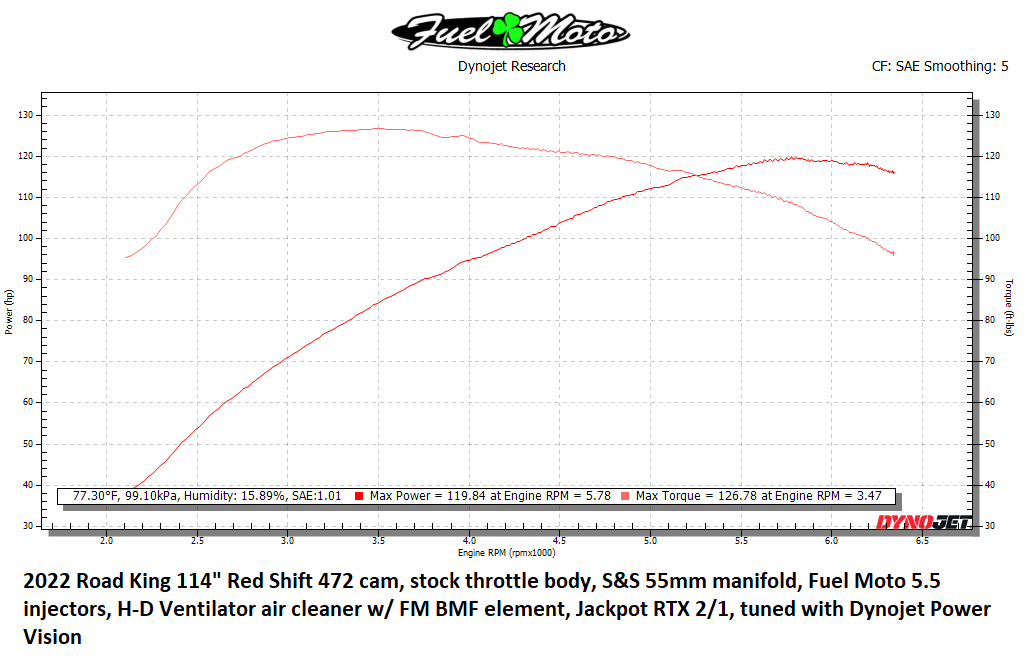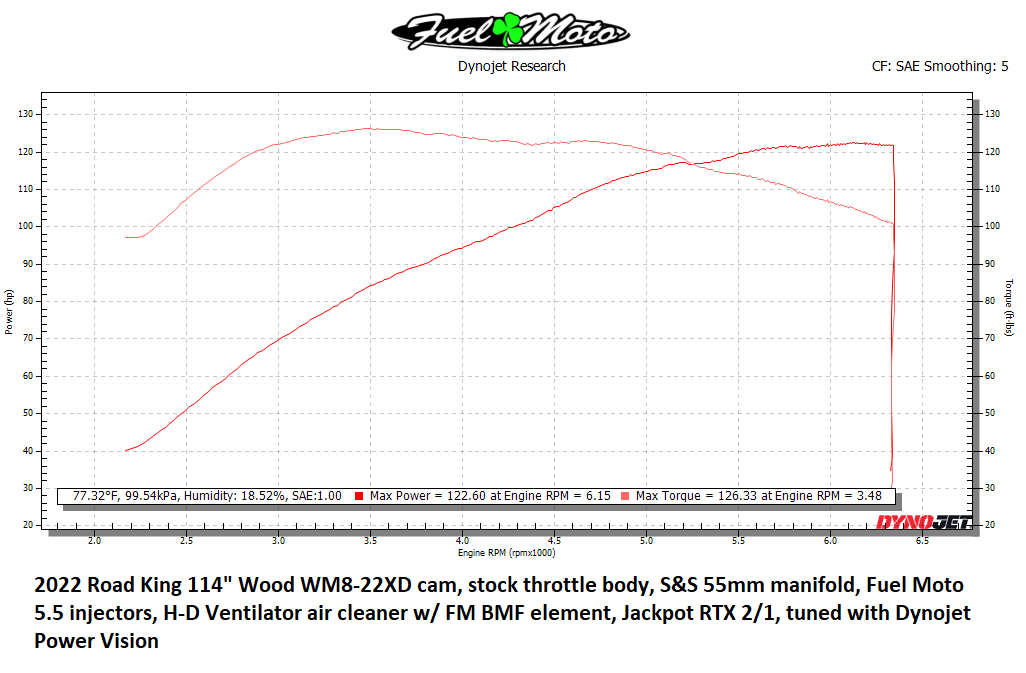our latest 2023 H-D Milwaukee-Eight 114″ Camshaft Shootout, we installed and evaluated 10 of the latest, most popular bolt in M8 camshafts. The grinds tested are marketed as performance cams for 107″, 114″, and 117″ engines.
Our test bike was a 2022 Harley-Davidson Road King equipped with 114″ engine and RDRS. The bikes performance modifications included a H-D Ventilator Stage 1 air cleaner with Fuel Moto BMF air cleaner element, stock throttle body with S&S Cycle 55mm intake manifold, Fuel Moto 5.5 fuel injectors, Jackpot RTX full length 2/1 exhaust system. We tuned the bike after each cam install with Dynojet Power Vision. The tests were performed over a four day period in our climate controlled dyno cell in no particular order.
The following cams were included for this 2023 H-D Milwaukee-Eight 114″ Camshaft Shootout:
Cycle Rama CR-480 and CR- 483
Star Racing 30/30
Fueling Parts 472
Ward Performance WP-475
Zipper’s Red Shift RS-472
S&S Cycle 475C
Wood Performance WM8-22XE, WM8-22XD, and WM8-777XE
The chart below represents an overlay of each of the cams tested.

S&S Cycle 475C
The S&S 475C may have been around for a while now, but it’s still a solid performer. This cam has a really good mid-range hit and pulls through the upper RPM’s well. Its huge amount of exhaust duration can make the 475 a bit soft on the bottom though and tuning can be a bit finicky (pick your exhaust wisely!). A high point of the 475 cam is its price, which is the lowest of each of the cams tested, a great value.

Zippers Red Shift 472
Zippers originally designed the 472 to complement the SE engine kits, however it lends itself very well as a stock bolt-in. This cam delivers a great combination of torque and horsepower and it comes on nice and early. One aspect we really like of the Red Shift cam profiles is the attention they give to the open & closing ramps, which really helps minimize valvetrain noise and wear.

Star Racing 30/30
Star Racing’s 30/30 has become a very popular bolt-in cam that offers great gains in horsepower & torque on both sides of the curve. Really nice all around camshaft and we especially like the smooth power curve it produces. This cam is on the high side of the price spectrum, with the highest retail price of the camshafts tested.

Ward Performance WP-475
The Ward WP-475 is the newest cam of the group and straight from Rick Ward’s playbook; quick acceleration with an emphasis on horsepower. With a little RPM, the WP-475 hits especially hard and really likes RPM. It showed the second highest horsepower of the group and is right up there in torque as well. Great overall curve. This cam could potentially be a little soft on the bottom with some exhausts.

Cycle Rama CR-480
The CR-480 is a well known performer with the M8 crowd. It made the best peak torque number of this test and is especially strong through the mid-RPM range. This cam really shines around 3,000-4,000 RPM. Where it sacrifices a bit of early torque and high RPM power compared to some others, it puts that power right in the middle making it a really fun cam.

Cycle Rama CR-483
The CR-483 tested very similar to the CR-480. It was slightly more rev happy, but was otherwise fairly identical. Really the same overall characteristics. This cam also shines through the midrange and puts up big torque.

Wood WM8-22XE
The WM8-22XE is one of the most popular M8 bolt-in cams available. This cam not only made the earliest torque of the test, but also the best average power throughout the curve. The XE did not make the highest peak numbers, but it puts the power down early and keeps pulling late. Its very responsive and really shines over the entire rev range.

Wood WM8-22XD
The WM8-22XD cam is essentially a hot rodded up version of the WM8-22XE cam, which gives it a bit more attitude. It trades a little early torque from the XE for some more high RPM horsepower. The extra exhaust duration also gives it a more aggressive idle. 
Wood WM8-777XE
The WM8-777XE is somewhat unique among this group as it was designed as max effort bolt-in. This pattern is quite a bit different than the others. The 777XE made the most horsepower by a pretty wide margin, but it also made the least amount of peak torque. The curve is also the flattest & smoothest of the test. Low RPM’s are still surprisingly stronger than several of the others, but this combo loves RPM’s.

Fueling 472
The Fueling 472 is a cam grind that really falls right in the middle of this test; which is a good thing. It makes very good overall power on both sides of the curve and shares the power characteristics we like. The 472 has a great curve and is a very easy cam to tune.

Additional Information for the H-D Milwaukee-8 114″ Camshaft Shootout:
- Results will vary based on different conditions, different components, different tuning, and different test procedures. What this means is if you have a different bike on a different day in different conditions with different parts, it’s unlikely your results will be the same as ours.
- Different parts, different results. Different components can & will affect the results for each of the camshafts tested; sometimes greatly, sometimes hugely! For example the exhaust system can completely change the overall curve and characteristics of each of the camshafts in this test.
- When comparing dyno charts, do not base your research on the single highest or best dyno chart you have found on the internet. Instead, base your info on an assortment of charts from well-known, reputable sources. Its also important to understand the charts that are being shared are apples to oranges comparisons. Some dyno charts weren’t even created on the same brand chassis dyno. Also be sure to reference the conditions on the dyno chart. These will indicate the actual temperature, pressure, and humidity the runs were performed in. As well as the correction factor that’s being applied. The most popular and widely accepted correction factor is SAE. Some dyno operators will use STD correction, which will produce numbers several % higher than SAE. If you want to compare charts, simply ask for the chart to be displayed as SAE to compare to other SAE charts or vice versa.
- Read our article on the differences between dyno charts and tuning shops here>> https://university.fuelmotousa.com/article/the-differences-between-dyno-charts/

